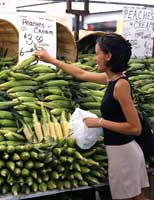Jun 30 2008
The term “natural” adds a premium to food products and makes them appear fresher, minimally processed, and safer. But consumers and the food industry will have to wait to know exactly what natural does – or does not – mean.

Scientific experts clarify the use of the term “natural” on products during the Institute of Food Technologists “Best of Food Thinking” Annual Meeting and Food Expo held Sunday in New Orleans.
Despite the term’s widespread use, the U.S. Food and Drug Administration (FDA) discourages the food industry from using “natural” on labels because of its ambiguity. As well, “natural” implies that a food product is superior, fresher, safer or more healthful than its counterparts, said the FDA’s Ritu Nalubola.
Neither FDA nor the U.S. Department of Agriculture (USDA) has precise rules for “natural.” And the food-and-beverage product industry, represented by the Grocery Manufacturers Association, has no consensus.
In 1991, FDA tried to define the term and, by 1993, gave up. It did decide to “not restrict the use of ‘natural’ on products. It is a very complex term,” Nalubola said. Today FDA is continuing that practice, originated in 1988. For a product to be called natural, it must be free of artificial or synthetic ingredients or additives, including color, flavor or any ingredient “not normally expected.” Hence, lemonade flavored with beet juice cannot be called natural. In addition, any food enhanced with caramel, paprika or color (consider bright orange cheese) cannot be called natural.
FDA will continue to judge products “on a case-by-case basis,” said Nalubola.
USDA, which regulates meat, poultry and egg products, is working on a more specific policy, said Daniel Engeljohn, Ph.D., of USDA’s Food Safety and Inspection Service.
Though not a food safety issue, he said that USDA’s policy will be in place by the end of 2008 and address such issues as tenderizing, processing and flavor-enhancing. Until then, he said, products and their claims will be weighed “case by case.”
In the grocery industry, disagreement reigns on the term’s definition, said Regina Hildwine, senior director of Food Labeling and Standards for the trade organization, Grocery Manufacturing Association.
Because such regulatory agencies as FDA and USDA haven’t clarified the term, products are subject to the agencies’ “best current thinking of what constitutes truthful labeling,” Hildwine said.
States have authority to set rules on some labeling matters, and a state could drive a future definition, Hildwine said.
At this point, she warns, “We don’t go too far or we might end up with something not everyone wants.”